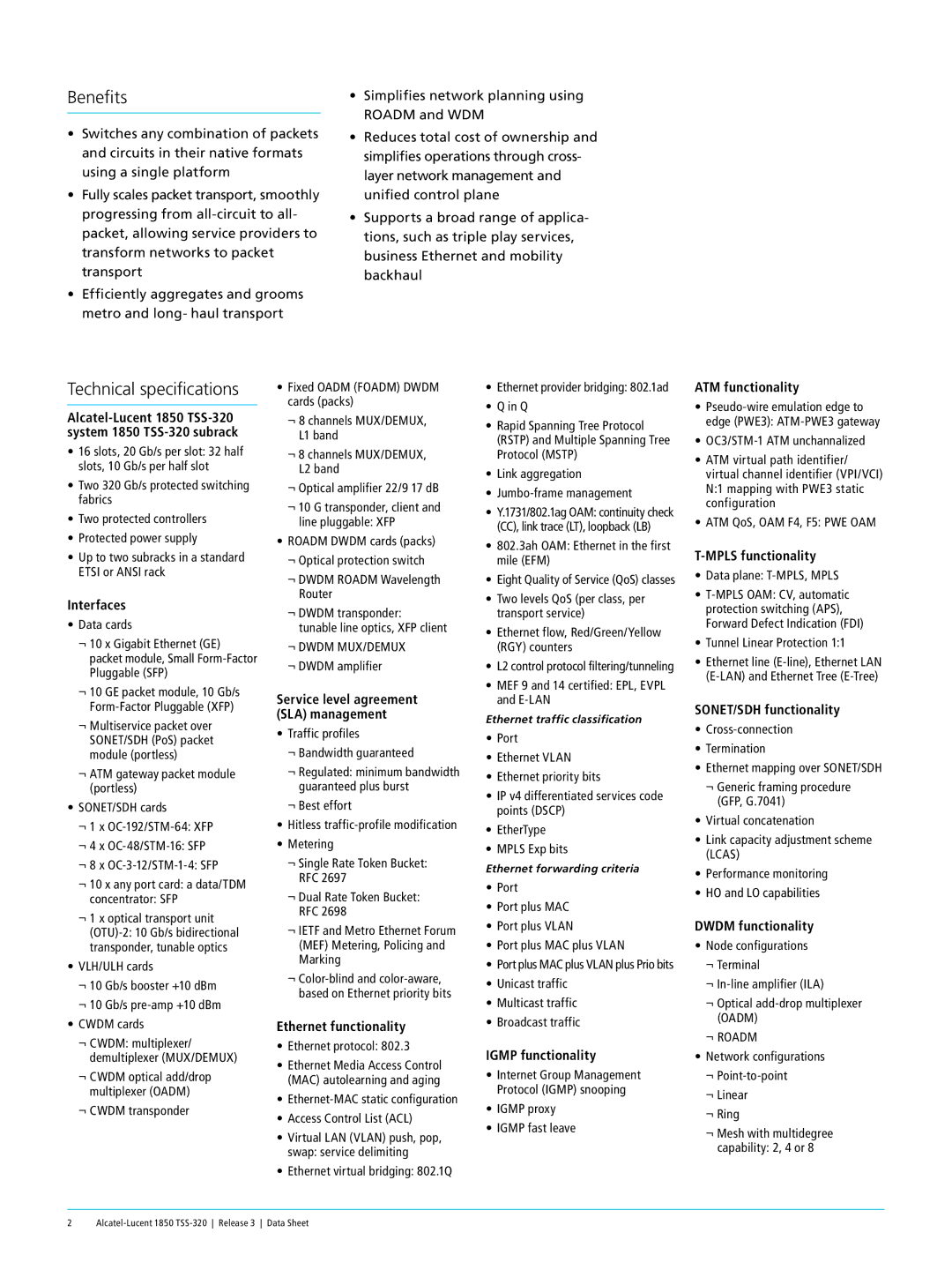
Benefits
•Switches any combination of packets and circuits in their native formats using a single platform
•Fully scales packet transport, smoothly progressing from
•Efficiently aggregates and grooms metro and long- haul transport
•Simplifies network planning using ROADM and WDM
•Reduces total cost of ownership and simplifies operations through cross- layer network management and unified control plane
•Supports a broad range of applica- tions, such as triple play services, business Ethernet and mobility backhaul
Technical specifications
•16 slots, 20 Gb/s per slot: 32 half slots, 10 Gb/s per half slot
•Two 320 Gb/s protected switching fabrics
•Two protected controllers
•Protected power supply
•Up to two subracks in a standard
ETSI or ANSI rack
Interfaces
•Data cards
¬10 x Gigabit Ethernet (GE) packet module, Small
¬10 GE packet module, 10 Gb/s
¬Multiservice packet over
SONET/SDH (PoS) packet module (portless)
¬ATM gateway packet module (portless)
•SONET/SDH cards
¬1 x
¬4 x
¬8 x
¬10 x any port card: a data/TDM
concentrator: SFP
¬1 x optical transport unit
•VLH/ULH cards
¬10 Gb/s booster +10 dBm
¬10 Gb/s
•CWDM cards
¬CWDM: multiplexer/ demultiplexer (MUX/DEMUX)
¬CWDM optical add/drop multiplexer (OADM)
¬CWDM transponder
•Fixed OADM (FOADM) DWDM cards (packs)
¬8 channels MUX/DEMUX,
L1 band
¬8 channels MUX/DEMUX,
L2 band
¬Optical amplifier 22/9 17 dB
¬10 G transponder, client and line pluggable: XFP
•ROADM DWDM cards (packs)
¬Optical protection switch
¬DWDM ROADM Wavelength Router
¬DWDM transponder:
tunable line optics, XFP client
¬DWDM MUX/DEMUX
¬DWDM amplifier
Service level agreement (SLA) management
•Traffic profiles
¬Bandwidth guaranteed
¬Regulated: minimum bandwidth guaranteed plus burst
¬Best effort
•Hitless
•Metering
¬Single Rate Token Bucket: RFC 2697
¬Dual Rate Token Bucket:
RFC 2698
¬IETF and Metro Ethernet Forum (MEF) Metering, Policing and Marking
¬
Ethernet functionality
•Ethernet protocol: 802.3
•Ethernet Media Access Control
(MAC) autolearning and aging
•
•Access Control List (ACL)
•Virtual LAN (VLAN) push, pop, swap: service delimiting
•Ethernet virtual bridging: 802.1Q
•Ethernet provider bridging: 802.1ad
•Q in Q
•Rapid Spanning Tree Protocol
(RSTP) and Multiple Spanning Tree Protocol (MSTP)
•Link aggregation
•
•Y.1731/802.1ag OAM: continuity check (CC), link trace (LT), loopback (LB)
•802.3ah OAM: Ethernet in the first mile (EFM)
•Eight Quality of Service (QoS) classes
•Two levels QoS (per class, per transport service)
•Ethernet flow, Red/Green/Yellow (RGY) counters
•L2 control protocol filtering/tunneling
•MEF 9 and 14 certified: EPL, EVPL and
Ethernet traffic classification
•Port
•Ethernet VLAN
•Ethernet priority bits
•IP v4 differentiated services code points (DSCP)
•EtherType
•MPLS Exp bits
Ethernet forwarding criteria
•Port
•Port plus MAC
•Port plus VLAN
•Port plus MAC plus VLAN
•Port plus MAC plus VLAN plus Prio bits
•Unicast traffic
•Multicast traffic
•Broadcast traffic
IGMP functionality
•Internet Group Management Protocol (IGMP) snooping
•IGMP proxy
•IGMP fast leave
ATM functionality
•
•
•ATM virtual path identifier/ virtual channel identifier (VPI/VCI) N:1 mapping with PWE3 static configuration
•ATM QoS, OAM F4, F5: PWE OAM
T-MPLS functionality
•Data plane:
•
•Tunnel Linear Protection 1:1
•Ethernet line
SONET/SDH functionality
•
•Termination
•Ethernet mapping over SONET/SDH
¬Generic framing procedure (GFP, G.7041)
•Virtual concatenation
•Link capacity adjustment scheme
(LCAS)
•Performance monitoring
•HO and LO capabilities
DWDM functionality
•Node configurations
¬Terminal
¬
¬Optical
¬ROADM
•Network configurations
¬Point-to-point
¬Linear
¬Ring
¬Mesh with multidegree capability: 2, 4 or 8
2
